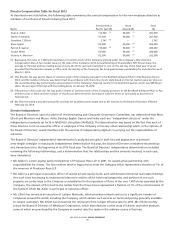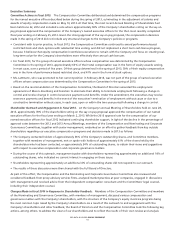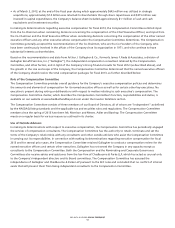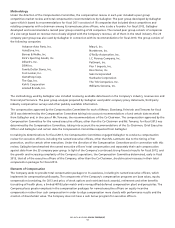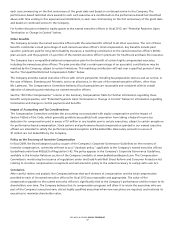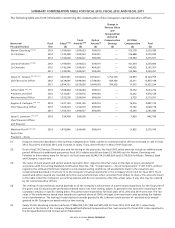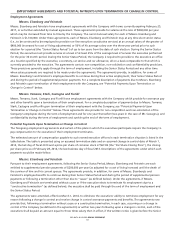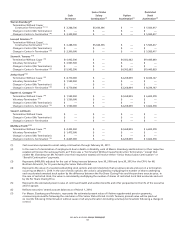Bed, Bath and Beyond 2013 Annual Report Download - page 57
Download and view the complete annual report
Please find page 57 of the 2013 Bed, Bath and Beyond annual report below. You can navigate through the pages in the report by either clicking on the pages listed below, or by using the keyword search tool below to find specific information within the annual report.Base Salary
The Company pays base salaries to provide its named executive officers with current, regular compensation that is appropriate
for their position, experience and responsibilities. Changes in base salary, if any, are generally effective in May of each
fiscal year.
Equity Compensation
The overall approach to equity compensation in fiscal 2013 was to make equity awards comprised of a combination of stock
options and performance-based restricted stock to executive officers, including the named executive officers (other than Ms.
Lattmann, who was not an executive officer at the time), and a small number of other executives. The Company’s allocation
between these two forms of equity awards considers the retention component and the role of the executive in the
enhancement of shareholder value. For the named executive officers receiving such awards in the spring of 2013 other than
the Chief Executive Officer and the Co-Chairmen, the allocation was more weighted toward performance-based restricted
stock in light of this retention component, yet provides a grant of stock options recognizing the role of these executives in the
enhancement of shareholder value. For the Co-Chairmen, the allocation reflects that each of them owns in excess of 1% of the
outstanding common stock of the Company. For the Chief Executive Officer, the even allocation of equity awards between
performance-based restricted stock and stock options was based on the view at that time that stock options reward executives
more directly for enhancing shareholder value and, therefore, as the executive primarily responsible for that enhancement,
the Chief Executive Officer should have a greater proportion of his equity awards allocated to stock options as compared to
the other executive officers. These grants are made on May 10 of each year (or the following trading day should such date fall
on a weekend or holiday). The vesting provisions relating to equity compensation have been and continue to be determined
with the principal purpose of retaining the Company’s executives and key associates. The Company believes its equity
compensation policies have been highly successful in the long term retention of its executives and key associates, including its
named executive officers.
Consistent with the Company’s historic practice, the stock options vest over time, subject, in general, to the named executive
officers remaining in the Company’s employ on specified vesting dates. Vesting of the restricted stock awarded to the named
executive officers in May of 2013 (other than Ms. Lattmann, who was not an executive officer at the time) is dependent on
(i) the Company’s achievement of a performance-based test for the 2013 fiscal year and (ii) assuming achievement of the
performance-based test, time vesting, subject, in general, to the executive remaining in the Company’s employ on the
specified vesting dates.
The performance-based test in fiscal 2013 required that the Company’s net income in that fiscal year be greater than or equal
to the Company’s net income in the prior fiscal year or that the Company’s net income as a percentage of sales placed it in the
top half of the companies in the S&P 500 Retailing Index with respect to such measurement. Net income may be adjusted for
such purpose to reflect items, such as: (i) mergers, acquisitions, consolidations or dispositions, (ii) changes in accounting
methods, (iii) extraordinary items, as defined in Accounting Standards Codification Topic No. 225, ‘‘Income Statement,’’ and
(iv) funds deployed for stock repurchase or dividend activity, to the extent permitted by Section 162(m) (‘‘Section 162(m)’’) of
the Internal Revenue Code of 1986, as amended (the ‘‘Code’’). The Company believes that this performance-based test meets
the standard for performance-based compensation under Section 162(m) of the Code, so that the restricted stock awards will
be deductible compensation by the Company for certain executives if their annual compensation exceeds $1 million. The
Compensation Committee believed that this test was an appropriate measure of performance for companies in the retail
industry and, specifically, for companies in the Company’s sector. In addition, even if the performance-based test was met, the
executive must remain in the Company’s employ for an extended period in order to earn the restricted stock, further aligning
the executive’s interest with the long-term interests of the Company and the creation of shareholder value over time.
The performance-based test was satisfied in that the Company’s fiscal 2013 net income as a percentage of sales placed it in the
top half of the companies in the S&P 500 Retailing Index with respect to such measurement.
All executives (other than named executive officers and other key executives whose compensation is determined by the
Compensation Committee) and associates awarded incentive compensation receive grants consisting solely of restricted stock.
Vesting of restricted stock awarded to these associates is based solely on time-vesting with no performance-based test.
Consistent with the Company’s practice since fiscal 2008, stock option awards are made in dollars (with the number of shares
covered by the options determined by dividing the dollar amount of the grant by the Stock Option Fair Value, as described
below). The Compensation Committee believes that making stock option awards in dollar amounts rather than share amounts
is advisable because making stock option awards in dollar amounts allows the Compensation Committee to align stock option
BED BATH & BEYOND PROXY STATEMENT
55


